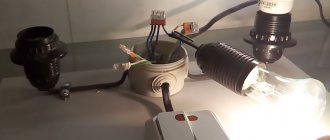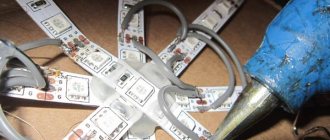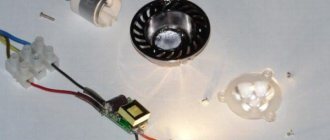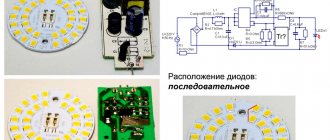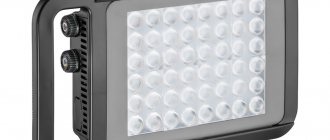From time to time, after installing energy-saving lamps, whether compact fluorescent or LED, people encounter problems such as dim glow or flickering of the lamp. Moreover, this happens when the lights are turned off, creating particular discomfort at night. This happens for various reasons. So, let's figure out why the energy-saving lamp blinks when the lights are off.
How the housekeeper works
Compact fluorescent ESLs cannot be connected directly to a 220 V network, so an electronic ballast circuit is located in their housing. The operating principle of this circuit is as follows:
The voltage from the 220 V network is supplied through a fuse to the diode bridge, after which it becomes rectified with a ripple of 100 Hz.
Further along the circuit there is an electrolytic capacitor that smoothes out ripples. Its capacity can vary depending on the power, it should be approximately equal to 1 µF per 1 W of lamp power. Next, the voltage is supplied to the self-oscillator circuit using two transistors, which contains:
- Dinistor DB3 with a switching voltage of about 30 V.
- A transformer with three windings (primary - with the largest number of turns and two base - a pair of turns each). It is wound on a ferrite ring with an internal diameter of about 3–5 mm.
- Two transistors type MJE13001–13003.
This circuit operates at a frequency of several tens of kilohertz.
The output part consists of a pair of capacitors and a power choke, usually wound on an W-shaped ferrite core.
The output circuits of the circuit are connected to the lamp coils.
The light-emitting bulb itself is a glass tube. It is filled with mercury vapor and coated on the inside with a phosphor.
Scheme of operation of an energy-saving lamp
Lamp arrangement
Before we begin to analyze the reasons why the light bulb blinks, it is necessary to understand its structure. After all, knowing the origins of the problem allows you to effectively eliminate the existing deficiency. Almost all energy-saving light bulbs have a similar operating principle and design. There are only minor differences. Let's consider the design of a light source using the example of a fluorescent lamp.
Lamp device
This device allows you to improve the energy-saving qualities of the product and make it more economical. In such a lamp, current flows through the diode bridge, thus entering the circuit. The latter includes a capacitor that smoothes out the ripple of the rectified current. To the question “why does an energy-saving light bulb blink when the light is off?” The answer is given by the capacitor, since the main cause of flickering lies precisely in it. The light is blinking because the capacitor is receiving current for some reason.
List of possible causes
The power supply circuit for an energy-saving lamp is quite complex, which is why the blinking occurs. However, fixing this problem is very simple. But first, I propose to understand the reasons.
Backlight on the switch
Some switches are equipped with backlighting, usually a neon indicator or LED. It is needed so that you can more easily find the switch in the dark, and it only lights up when the lamp is turned off. To light the indicator in the switch, a small current is needed; when incandescent lamps were used, this current passed through the circuit: phase wire - indicator - lamp - neutral wire. This current did not affect the lamp, no one asked this question. When they started using energy-efficient light sources, the problem of flickering arose.
The current flows through the indicator to the input of the electronic ballast, through the diode bridge it charges the smoothing capacitor, when the voltage on its plates reaches the required value - the circuit turns on and the light bulb begins to glow, this period is very short, and you only see a flash.
A similar situation occurs with LED devices.
The backlight on the switch is a useful feature, but can lead to malfunction of energy-saving bulbs
Electrical wiring problems
The condition of the electrical wiring also affects the flickering of energy-saving lamps. Old wiring is likely to have poor insulation, allowing small currents to flow between the wires and to the switch. As a result, current flows “past” the switch. Next, the process of charging the capacitor and flashing the light occurs as described above. This is called current leakage. In addition, the flow of unnecessary currents can be affected by the humidity of the walls; through wet walls, the phase flows through the lamp to zero or ground. And the third reason may be the large length of the cable, due to which parasitic capacitance occurs. A capacitor is two conductive plates separated by a dielectric; in this case, the role of the dielectric is played by insulation. In alternating voltage, unlike direct voltage, currents flow constantly through the capacitor.
Poor quality lamp
The reason may lie not only in the external components, but also inside the lamp itself. In high-quality luminaires, the circuit has filters and other means of reducing the influence of various interference on their operation. Do not buy cheap Chinese lamps, they not only have a lot of disadvantages (pulsation, low color rendering index, etc.), but are also generally dangerous. In any case, for normal wiring, use a switch without backlight.
Make sure to choose a quality lamp
LED light blinking
The time has come when fluorescent lamps are gradually starting to leave our everyday life. They are being replaced by the most modern LED solutions. They are even more economical, practically do not heat up and shine with a light that is very pleasant to the eye, adding even more comfort to your home. And, despite their rather high cost, they are found almost everywhere. The emitters in the lamps are new, but problems remain? Does the LED lamp flash even when the contacts in the switch are open? No problem - let's figure out why.
Here the symptoms expand a little - in addition to the fact that it flickers, a very weak glow of the crystals themselves can be observed, but it is very noticeable in a dark room and is not very pleasing to the eye.
- How to remove blinking? The reason is still the additional lighting in the switch. The same principle works here - either replace the switch completely, which is very expensive in total, or physically disconnect this small module by disassembling the switch.
- Why is the LED lamp blinking? To absorb the small current that has a bad effect on our light bulb, in addition to the resistor, you can also use a small capacitor. For household purposes, an option with characteristics of about 600 volts and a capacity of about 0.01 μF is suitable. If you use a capacitor designed for a standard network voltage of 220 volts, then it may fail during a sudden voltage drop and will have to be replaced. It’s better to immediately take a good supply, their cost is low.
Capacitors of various modifications and powers.
It has no polarity; you can connect wires to any of its legs. The main thing is that the connection is made parallel to the LED light bulb. As a result, the accumulation of slipping current in the capacitor, we get a non-blinking diode light bulb.
- The previous point is relevant for switches that have only one backlit button. However, if there are two such keys, how to remove the flickering of LED lamps? They each control their own groups, these groups are influenced by each individual luminous module in the switch itself. Therefore, it is not enough to connect a resistor or capacitor to only one group. How to eliminate flickering of LED lamps in this case? A similar action must be performed for all emitters that are powered by each key.
Switch with two keys and separate backlight
- But it also happens that the lamp blinks after turning off, even when additional modules are installed. The standard connection diagram is that when the contacts in the switch are opened, the phase is switched off, but the zero remains constant. If there is a constant phase to the light bulb, then the device is under constant load, and the starter continues to charge, even with conventional switches without backlighting. This is a common reason why the LED blinks.
- If next to a wire connected according to all the rules, another power cable with weak insulation runs in the wall, it can transfer potential to our light bulb. Moreover, if a resistor or capacitor is connected to the point of contact of the wires in the wall, it will not help at all to avoid the unpleasant effect. The solution is to place the resistance as close as possible to the light bulb to eliminate flickering.
Eliminating the cause of the problem
The problem of lamp flickering can be solved without the involvement of specialists. To do this yourself you will need a small set of tools:
- Screwdriver.
- Voltage indicator (indicator screwdriver).
- Wire cutters.
- Heat shrink.
Removing the backlight
The most radical and reliable way to eliminate outbreaks is to remove the source of the problem completely. To do this, use a thin slotted screwdriver to remove the keys from the switch. After this, follow the instructions:
- Make sure that the lamp is de-energized using a voltmeter or phase indicator; it is better to turn off the circuit breaker.
- Unscrew the screws securing the switch.
- Remove it from its seat.
- On the back side there will be a small box in which the backlight is located.
- Remove the backlight.
- Otherwise, look at how the indicator is connected and break its power supply circuits.
- Ready!
Read also: What is the temperature in the fire?
Leave the backlight on while changing the power circuit parameters
Another way is to solder a higher resistance resistor to power the indicator and a 1n4007 diode.
Soldering a resistor into the circuit is one of the options for solving the problem of flickering light bulbs
As already mentioned, there is either a neon bulb or an LED installed there. For an LED, the resistance is about 500 kOhm, for a neon - 200–300 kOhm. The diode will cut off one half-cycle of the supply voltage. This modification will generally eliminate flicker. The difficulty is that the backlit board is quite small, so you need to be able to handle a soldering iron and small components. If you are not satisfied with this option, move on to the next one.
We create a circuit with lower resistance parallel to the lamp
When you don’t want to remove the backlight because it’s convenient and you’re used to it, you can find another way out of the current situation. To do this, you need to give the current a path to bypass the lamp. Buy a resistor (another name is resistance) at any radio parts store with a power of 2 Watts and a nominal resistance of 50 kOhm (thousands of Ohms).
Now it needs to be connected in parallel with the lamp. You can do this either in the distribution box, connecting between the phase coming from the switch and zero, or in the body of the chandelier or sconce itself, where the flickering lamp is installed.
Conscientious manufacturers install this resistor on the electronic ballast board inside the ESL, and it does not blink with such a switch. Well, cheap Chinese brands rarely take their products so seriously.
How to choose an LED lamp?
From my own bitter and costly experience, I can say that lamps can be selected according to one of the following principles, arranged in descending order of guarantee of a good result:
- In an auto store, purchase a branded LED lamp from a well-known brand (Osram, Philips, etc.) with a guarantee.
- In an auto store, buy a lamp from a lesser-known brand with a stated one-year warranty.
- Buy an LED lamp with an operating voltage range of 12–24V at an auto store or order online. Universal, that is, suitable for trucks, the lamp should work flawlessly at 14.8 volts in a passenger car.
- On the Internet, try to choose a lamp with a metal radiator and it is very desirable that its operating voltage range is indicated as 8.0–14.5 volts.
- Choose the cheapest plastic one. Buy a whole grain and prepare to change it every other day.
And there are also cars on the roads whose rear brake lights, thanks to microcircuits built into the LED lamps, blink specifically for the delight of the owner. The solution is unconventional and confuses drivers driving behind. I do not recommend using such lamps in brake lights. They may even moor at your stern.
Why does the light blink when connected correctly?
If all connections are correct, check that the electrical wiring is installed correctly. The switch must open the phase wire. When your zero opens, the ESL may blink. In this case, you need to reconnect the lamp in the distribution box, connect the zero directly to it, and connect the phase to the switch; in some cases, you may need to re-lay the cable.
Incorrect wiring may cause lamp problems
It's another matter if the light bulb is located at a great distance from the switch and junction box. EMF can be induced on the supply wires. It often causes flickering. The source of interference can be nearby cables and various gadgets that use radio transmission and wireless technologies, as well as any other sources of alternating magnetic field.
Briefly about the main thing
The blinking of the light when the power is off is directly related to a fault in the wiring. It happens that an error occurs when connecting the wires in the switch. And instead of the phase, the breaker was set to zero. If you swap the wires, the problem is solved.
But most often the light bulb flickers when using energy-saving lighting devices. When their switch is backlit. In this case, the problem can be solved either radically (removing the backlight unit) or by modifying the circuit. An additional resistor is soldered into it.
Safety precautions
This is not so important for you in everyday life, so you need to adhere to the following rules:
- Turn off the voltage completely - open the circuit breaker at the entrance to the apartment.
- Do not work if the environment is humid, this means both water on the floor and wet walls.
- Use tools with handles insulated with dielectric material.
By following these three simple tips, you will save your health and life.
In the modern world, users are increasingly using their energy-saving “sisters” instead of conventional incandescent lamps. However, along with convenience and savings, unexpected problems arise during the operation of such electrical appliances. Among such “surprises”, the blinking of a lighting device after being turned off is often mentioned. Why do energy-saving light bulbs blink? Let's figure it out.
The second reason
When wondering why a fluorescent lamp blinks, one cannot rule out a reason such as a zero interruption. In this case, during operation of the lighting device, a phase constantly flows to it. Zero appears only after the light bulb is turned on.
Solution
To correct the situation, you simply need to reconnect the phase and neutral. To do this, you need to establish where exactly the interrupt occurs. There can be two such places: an electrical panel in the entrance or a distribution box in the apartment. Before reconnecting the wires, you need to make sure that when you turn off it is the zero that opens, and not the phase.
To perform this action, you need to touch each wire one by one with an indicator screwdriver. If the neutral wire does not show voltage when the lights are off (the screwdriver indicator does not light), then this is where the reason lies.
To solve the problem, you need to reconnect the wiring to the switch from the panel or distribution box. This can be done in two ways: swap the zero and phase or run new wires.
How it works? Difference between different types of lamps
As you know, manufacturers produce several types of lamps. Until recently, the most famous and widespread were ordinary incandescent lamps. Such a lighting accessory emits light due to very strong incandescence, heating of a special wire inside a glass bulb. It is called the "filament".
There are also fluorescent and energy-saving light bulbs. There is no filament in such lighting fixtures. The operation of such lamps is carried out due to the formation of a potential difference. In this case, electrons flying inside the device in the gas cause it to glow.
Before we begin to understand why energy-saving light bulbs blink, let’s determine what conditions they have.
- There is no power to the lamp and it is turned off.
- There is a slight voltage coming to the light bulb. Sometimes it may be a small amount of current, too small to start it. In this case, the capacitor is gradually charged. When sufficient voltage accumulates, the light bulb turns on briefly. However, the capacitor is instantly discharged, and the device immediately goes out. This process looks as if an energy-saving light bulb is blinking.
- When sufficient power is supplied for normal operation of the lighting fixture, the light bulb turns on. The device serves to perform its main function - illumination of a room, objects, area, etc.
Now that you have become a little familiar with the principle of operation of energy-saving light bulbs, you can begin to understand why energy-saving light bulbs blink.
What is an LED lamp
- Turn off the circuit breaker that powers the lighting circuits;
- Check that there is no voltage;
- Remove the switch mechanism;
- Remove the indicator by disconnecting its ends from the lighting circuits;
- Reinstall it and check the operation of the LED lamp when it is on.
Useful tips Connection diagrams Principles of operation of devices Main concepts Meters from Energomer Precautions Incandescent lamps Video instructions for the master Testing with a multimeter
How to deal with blinking? Method one
We previously wrote about why a switched off energy-saving light bulb blinks. At the same time, the incandescent lamps screwed in instead of the housekeepers do not blink. Therefore, the simplest solution would be to replace energy-saving lamps with their “sisters” with filament. However, with this option you will have to forget about economical consumption of electricity.
Read also: Marking of O-rings
Of course, you can pick up several low-power lamps. However, in some cases, such a solution is not very rational (for example, there is only one lamp horn in the lampshade, but you don’t want to use a lamp that is too powerful). Now that you understand why energy-saving light bulbs blink, you can add one more touch to them: solder a 10-20 kOhm resistor in parallel with the socket. This element will “pull back” the small current that caused the blinking.
Using a pass-through switch
The science of blinking of switched-off lamps does not stand still). This is an update to the article dated July 26, thanks to reader Sergei for the tip. See his comment to this article dated July 25, 2014.
When the lamp is turned off, the potential, due to which it tries to turn on, appears for two reasons (often these reasons are present simultaneously): 1) The potential appears due to the flow of backlight supply current, 2) The potential appears due to interference from nearby current-carrying conductors.
By the way, it is almost impossible to measure this parasitic voltage with a conventional voltmeter, or the readings will be greatly underestimated - because the voltmeter itself will act as a shunt.
The idea is that the parasitic potential is shunted by the contacts of the pass-through switch. Here is a diagram from which everything will be clear:
Pass-through switch to eliminate flickering of a switched-off lamp
The top position of the switch according to the diagram - the lamp is on, everything is clear here.
Turn off the lamp, switch position is down. The backlight is powered by neutral through the switch contacts (and not through the lamp, as usual), and the lamp is connected to the neutral wire on both sides. Everything is iron-clad, no interference or stray potentials.
Also read comments on this topic for July 25, 2014 and later.
In order not to miss new articles on the SamElectric.ru blog, subscribe, and new articles will be sent to your mailbox immediately (within a second) after publication!
The second way to deal with blinking
If you have exactly this situation, there is a need to reconnect the zero and phase on the lighting group in the panel if such phenomena occur throughout the house or apartment. The situation may turn out to be simpler - sometimes it is enough to restart the circuit, only in a certain junction box.
Before performing any actions, you need to make sure that your switch actually opens not the phase wire, but the neutral one. To carry out such manipulations, it is enough to use the indicator. You just need to touch each of the wires connected to the switch.
When your indicator does not show the presence of voltage (while the indicator itself is working), then in this case the real reason is a broken neutral wire. It is necessary to reconnect it in the distribution box or switchboard. Now you already know exactly what to do if the energy-saving light bulb blinks after being turned off.
Incorrect installation or faulty wiring
Attention! If you change the phase with zero in the electrical panel, the flickering of the light bulb will disappear. However, if you don’t understand much about electrics, then it’s better not to do this yourself.
It is worth mentioning that the cause may also be faulty electrical wiring, which, if disturbed, results in large leakage currents.
Return to content
Another way to deal with blinking
Sometimes it is enough to swap incandescent light bulbs from one room with “housekeeper” lamps from another. As they say, “cheap and cheerful.” Screwing at least one regular incandescent lamp into a multi-arm chandelier along with energy-saving light bulbs can also help. It is important to place it in a cartridge that can be turned off using a backlit key.
Manufacturing defect
Another reason for the flickering of a light bulb may be poor quality manufacturing. Currently, there are a lot of defects on the market; products are not made according to standards and therefore fail almost immediately. After purchasing a light bulb in a store, you must immediately check it and, if any faults are found, ask to replace it with a working one.
Attention! If flickering occurs in an energy-saving light bulb, it is necessary to eliminate it as quickly as possible, since the element of the lamp that provides the glow, when flickering, is subject to a temperature difference due to the difference in voltage applied to it, which causes destruction (wear) of this element.
Return to content
Why does the energy-saving light bulb blink? Is it harmful?
First, determine whether you are a nervous person. For many people, a flashing energy-saving light bulb gets on their nerves. In the dark, such blinking can scare not only younger family members, but also adults. Many users, when faced with this problem for the first time, are seriously scared, thinking that the problem is faulty wiring. Some are afraid of a short circuit and, as a result, a fire.
Third reason
It is quite possible that the electrical wiring in your apartment is already outdated. Old wiring is characterized by damage to the insulating layer, which leads to leaks and voltage surges in the home network. As a result, the energy-saving light bulb blinks.
Solution
You need to roll up your sleeves and start a major renovation of your apartment. This needs to be done not only to remove the flickering of lighting fixtures. Old wiring can not only damage electrical appliances, but also cause a fire in the apartment. So, wondering why the light bulb is blinking, you can motivate yourself to make repairs that have been put off for many years. Of course, if you notice the blinking of lighting fixtures, you don’t need to immediately tear off the wallpaper and trench the walls. First try other ways to get rid of the problem.
Afterword
It is of great importance which manufacturer you prefer. Many people purchase cheap energy-saving light bulbs, guided by the principle “saving means saving on the purchase price.” You should know that well-known companies are trying to produce products not only of higher quality, but also more advanced ones. This also applies to energy-saving light bulbs.
Most cheap lighting products are made from low quality raw materials. As a result, the service life of such products is short. Energy-saving light bulbs made from higher quality and more expensive raw materials will not only be safe for you and your family. They will last much longer - the service life of products manufactured under well-known brands can last five to eight years. Now think about it: is it really more economical to buy several light bulbs during this period, or is it more profitable to buy one expensive, but high-quality one? The conclusion suggests itself.
Now that you know why the energy-saving light bulb blinks and what are the ways to solve this problem, all you have to do is start taking action!
Most users in their homes have already replaced conventional incandescent lamps with energy saving ones. However, when purchasing economical lamps, you have to deal with an unusual phenomenon.
It turns out that energy-saving and LED light bulbs in chandeliers and lamps begin to blink with weak flashes (even when the lighting is turned off). This is especially noticeable indoors at night. However, when replacing an economical lamp with the most common incandescent light bulbs, the phenomenon immediately disappears.
It all started when a neighbor came to me and started complaining that the store sold him defective energy-saving lamps. Yesterday he says he bought and installed five light bulbs in a five-arm chandelier. They work great, they shine well, but in the evening when I was getting ready to go to bed, I turned off the chandelier and I was sleeping, talking like I was at a disco, all these five lights blinking periodically.
What could be the reason? We came to his house, and indeed, when the chandelier is turned on, the lamps shine normally, but when the switch is off, they begin to blink, and that’s it. Well, I think there might be a bad contact somewhere in the chandelier or something else.
After examining all the contact connections of the chandelier, everything was in order, no questions arose at all. But there was one point - the switch was with LED backlight. So, why does the energy-saving lamp flicker after being turned off? Let's find out in this article.
Causes of flickering
An energy-saving lamp can flash in a variety of situations:
- Constant flashing when the switch is on;
- only at the moment of switching on;
- occasional blinking during operation;
- with the switch off.
Flickering in the absence of power is caused by the characteristics of the switches of individual models and errors by electricians when laying electrical wiring. The cause of flickering may be an insufficient quality lighting source. To fix the problem, you will have to identify its root cause.
Switch with LED light
Flickering is often caused by a faulty key switch operating with neon or LED backlighting.
Causes of the problem:
- The closure of power contacts that occurs as a result of turning on the device.
- The illumination lamp lights up.
- Movement of a weak current according to the network-lighting source-network circuit.
- Charging a capacitor on the circuit of an energy-saving light bulb.
At the last stage, the capacitor is charged at lightning speed and the whole process is repeated again. To solve the problem, you will need to open the current circuit by removing the backlight in the switch. In addition, the circuit parameters should be changed so as to make charging the capacitor impossible. Replacing the switch with another that does not have a backlight helps.
Note! It is unacceptable to combine energy-saving light sources and backlit switches. Even if there is no blinking, the working life of the lighting device is consumed extremely quickly in this case.
Wiring errors
Often the root cause of blinking is incorrectly installed electrical wiring or a connection error, which leads to large current losses. The issue is solved by installing a conventional resistor. The device can be placed in the inside of the junction box or on a lighting fixture, but only if the lamp is working in parallel.
Another cause of the problem is an excessively long electrical cable connecting the energy-saving light bulb to the switch. The cable is directly proportional to the area of the conductor, which leads to an increase in potentials and overflow of the radio wave ether. This charges the capacitor and the lamp flashes even when the power is turned off.
The next reason for flickering is an incorrect connection of the switch. A common mistake is direct laying of the phase wire to the lighting device or breaking the neutral through the contacts. It will not be possible to solve the problem with a shunt resistor, since this is hampered by voltage drops in the network and too weak a current flowing through the backlight. The way out is to dismantle the distribution box and correctly connect the phase wire to the switch.
Insufficient quality of light bulb
Poor quality lighting fixtures are another factor leading to flicker. To avoid this problem, it is recommended to adhere to a number of rules:
- You should select a light bulb taking into account the power parameters, which are contained in special tables and indicated by the manufacturer in the product labeling.
- Many energy saving lamps have an E27 base. However, if we are talking about local lighting, E14 sockets are needed.
- Different types of rooms require different color temperatures. For offices this is 6 - 6.5 thousand on the Kelvin scale, for living rooms and children's rooms - 4.2 thousand Kelvin, and for a kitchen or bedroom - 2.7 thousand.
You should not purchase too cheap lighting fixtures from little-known manufacturers. Such savings often result in rapid breakdown of the device. Products from well-established companies are a smarter choice. The warranty period for the product ranges from 6 to 18 months.
Insulation problems
A common cause of flickering is significant current loss in the network. If the source of the problem is poor-quality contact, the issue can be resolved by cleaning the oxidized conductor and contact pad. In addition, the bolt should be securely tightened and the connection soldered.
The consequence of poor insulation will be flickering, since there is current loss on the line, resulting in an uneven glow. A sign of poor-quality insulation is frequent and seemingly causeless knocking out of the machine. To determine the problem area, you will need a multimeter. After turning off the power supply, switch the device to ringing mode. One of the probes is directed to the bare wire, the second to the ground loop. The multimeter will notify you of the existing breakdown with a sound signal.
Be sure to check that there is no communication between the wires in the cable. For this purpose, the probes sequentially touch each of the existing wires.
An even more reliable device for determining damage in the insulating layer is a megohmmeter. However, only specialists have such a device.
How modern energy-saving lamps work
We’ll look at the question of why a switched-off energy-saving lamp blinks a little later; now we’ll figure out how modern energy-saving lamps work.
Did you know that, unlike incandescent lamps, fluorescent and LED lamps operate from a constant power source, that is, they operate at a constant (rectified) voltage. How can you ask? After all, the lamp is supplied with an alternating voltage of 220 V; there are no rectifiers in the sockets or chandeliers. I assure you, there is, and this rectifier is located inside any modern lamp.
Read also: DIY plywood models, drawings
Inside each energy-saving lamp, between the base and the tube, there is an electronic board (in professional language they are called electronic ballasts), thanks to which they work.
An alternating voltage is supplied to the input of a special rectifier (diode bridge), and at the output we have a constant or rectified voltage.
I will not go into all the details of the operation of these circuits, but in order to smooth out the ripples, a special smoothing capacitor is installed. It is precisely because of this capacitor that the energy-saving lamp blinks. And in what case this happens, and under what circumstances, let's look at it below.
Design and principles of operation of energy-saving light bulbs
Modern industry produces two types of energy-saving lamps - fluorescent and LED. They differ in internal filling, but both are capable of operating in a wide range of current values. The spread can reach tens of Amperes. Both mercury and LED bulbs produce bright light and consume little electricity.
The principle of operation of a fluorescent light bulb
Energy-saving lighting sources are based on the ability of mercury vapor to glow. Fundamental features of a fluorescent light bulb:
- When the power supply is connected, the current is directed through the electronic ballast (electronic ballast). The purpose of the electronic ballast is to give the current the required parameters and heat the electrodes. In the device, the current is transformed and supplied to the electrodes.
- By coating the tungsten electrodes with a mixture of metal oxides, mercury vapor ionizes. The reaction is carried out in a glass flask. Mercury vapor produces an ultraviolet glow.
- The glass walls of the flask are coated with a phosphor, which converts the ultraviolet spectrum into the desired one. The required spectrum depends on the chemical components of the phosphor.
Operating principle of LED lamp
The components of an LED light bulb include a base, a current converter, and luminous elements. The lighting source is an LED strip, which is a flexible board in which LEDs are mounted at equal distances from each other. When exposed to electricity, LEDs (analog semiconductors) emit a glow.
LED light bulbs are environmentally safer than fluorescent ones. Mercury and metal oxides are used to make luminescent devices, and these substances are dangerous to living beings. It is for this reason that energy-saving light bulbs should not be mixed with regular trash. Such light sources are subject to specialized disposal.
The LED is a very small, chemically neutral crystal mounted in a transparent housing. The crystal is connected to metal contacts. Diodes are safe because they do not contain harmful elements. When connected to an electrical outlet, the crystals emit a bright glow, although due to their light weight the thermal energy released is negligible. The highest temperature of a heated LED does not exceed 60 degrees.
LEDs can only glow at low current, so special capacitors are installed on them. Such devices do not allow the lamp to turn on immediately, but only when the current reaches the desired threshold value. The most common reason for the flickering of an LED lamp is some kind of breakdown in the electronic ballast.
Why does a switched off energy saving lamp blink?
Let's return to the first section of the article, with a neighbor, a backlit switch and energy-saving lamps. I would like to draw your attention to the backlit switch, since the problem is why the switched-off energy-saving lamp blinks precisely in it.
What physical processes occur in illuminated switches? When the switch is turned on, its power contacts are closed. When the switch is in the off position, the lamp in the backlight lights up (because that’s why it’s installed there).
And if the lamp is lit, then an electric current flows through it, which moves along the following path: network - backlight lamp - chandelier with a lamp - network. This current is very small (about hundredths of an ampere) and does not affect the overall network load (the electric meter does not respond to it).
The current flowing through the backlight serves as a charge for the capacitor in the electronic circuit of the light bulb. As soon as it receives a sufficient level of recharging to turn on, the circuit starts up, which is why a flash is produced. Further, after a short flash, the capacitor is immediately discharged, and the process is repeated again.
When using a backlit switch, there is a flickering effect that bothers everyone so much. Therefore, when a backlit switch and a compact fluorescent lamp are used, this flashing effect occurs. You turn off the switch, the light in the key lights up and the lamp begins to flash periodically.
| The negative aspect of all this is that the circuit inside the lamp is designed for a strictly timed resource in terms of the number of starts. Thus, the internal reserve inside the lamp is used up within 1-2 months, after which it can be safely thrown into the trash. |
A similar situation is with low-power power supplies for LED strips. “At the input” of the source, exactly the same diode rectifier and capacitor are provided.
Accordingly, a small compensating current flows in the backlit switches, and the capacitor has time to recharge. In this regard, the switched off LED strip begins to work in smoldering mode with periodic flashes of light.
| PS Self-respecting manufacturers provide the consumer with the following information on the packaging: “not for use with backlit key switches, photocells, brightness controls, dimmers, timers, etc.” Remember, these devices force the energy-saving lamp to work in critical (abnormal) mode! |
How to eliminate the cause of blinking energy-saving lamps
- 1) Probably the simplest solution would be to remove the backlight. To do this, open the switch cover and disconnect the wires that power the backlight. Or you can simply cut this wire (do not confuse it with power wires).
In this case, when the switch is turned off, the current that recharges the capacitor will not flow accordingly - the lamp does not blink.
- 2) Do not use a backlit switch. Replace all backlit switches with regular ones where energy-saving lamps are used.
- 3) Connect a regular incandescent lamp in parallel with an energy-saving lamp. This method allows you to eliminate the blinking of energy-saving lamps, since the current that charged the capacitor will go to the filament.
But I believe that this method does not really have a place to exist, since the point of all this saving and modernization. Moreover, there is not always room in the lamp to install an incandescent lamp next to an energy-saving one. But that's my personal opinion.
- 4) There are switches in which the backlight is an integral part, for example, it works as a decorative element. What to do in this situation?
If an energy-saving lamp blinks after being turned off , one way to solve the problem is to connect an additional resistance (resistor) in parallel with the lamp.
The resistor should be 2 W with a nominal resistance of 50 kOhm. The cost of such a resistor is a penny, about 10 rubles. You can purchase it at any amateur radio store.
This resistor does not affect the normal operation of the lamps in any way, but when the switch is turned off, that is, when the backlight is on, this resistor will consume the current that recharges the capacitor in the lamp starting circuit.
For safety, we insulate the resistor using heat shrink tubing. The connection can be made in the ceiling lamp, junction box or at the lamp socket itself. To connect such a resistor, you can use special Wago terminal blocks.
After connecting, carefully place the resistor in the box. The entire reason for the flickering of the energy-saving lamp has been eliminated. See you in the next lessons. I hope this article helped you understand the question of why the energy-saving lamp blinks after being turned off. Subscribe to the YouTube channel.
Why the lights in the apartment are blinking: ways to solve the problem yourself
You are having dinner, or sitting comfortably on the sofa with a magazine. The light blinked, then again and again. Even if this happens occasionally, you must agree: when the lights in the apartment blink, it’s annoying. But in this case, is it always necessary to call an electrician, wait and incur additional costs? In some cases, the cause can be found and quickly eliminated yourself. Moreover, without any risk and without an electrical safety clearance group.
Warning!
But let us remember firmly: without the qualifications and skills of an electrician, without special tools and protective equipment, it is impossible to carry out work on ANY electrical equipment, including household electrical appliances! You can only use the standard controls without disassembling anything.
Electric shock will not warn you in advance, and its consequences are unpredictable and can be long-lasting. Especially if you have been drinking alcohol. Already from a shot of vodka, a person’s electrical resistance drops 1000 times, and an otherwise harmless pinch can turn out to be a fatal blow.
Option 1: The light bulb in the stationary lamp is blinking
First of all, why are the lights blinking in the apartment? If one light bulb in a stationary lamp (or one section in a chandelier) blinks, then either it, or the switch, or the wiring section between them is faulty.
Let's listen to the switch, with a closer ear. Do you hear something like a faint crackling or hissing sound? If yes, bad contact. The switch, however, may be in good working order, but dirt has just gotten onto the contacts or into the spring. Unscrew the flashing light bulb and quickly click the switch several times. Please note - with the light bulb unscrewed, no load! Otherwise, the already weakened contacts may burn out, and the switch will completely deteriorate. Screw in the light bulb again. Did it help? If not, move on.
We replace the flashing light with a known good one. If there is no spare, temporarily unscrew it from somewhere. Is that how it blinks? Well, the problem is in the wiring or in the electrical fittings of the lamp. This is already the work of the master.
Option 2: The light bulb, powered by the socket, is blinking
If the lamp plugged into the socket is blinking, try plugging it into an socket that is known to be working, go to several sockets in turn. Has it stopped blinking? The “original” socket is faulty and needs a technician and repair.
Is that how it blinks? We repeat the procedure for checking the switch and light bulb. Did not help? Well, the lamp needs to be repaired or replaced.
Option 3 (global): The light flashes throughout the entire apartment
- Let's say there is at least one room in the apartment where the light does not blink . Then, most likely, the problem is in the “dose” - the distribution box inside the apartment. There is no need to go there yourself, but your information may be useful to an electrician.
- Flashes “the whole apartment? “We look out the windows. If it also blinks in neighboring houses, there is a fault at the substation or in the main supply cable - feeder. You need to inform the emergency utility service or directly to the power grid dispatcher - the number will be given at the help desk.
- Do the lights in neighboring houses burn smoothly? Let's look into the entrance - how is it there, is it blinking? Let's ask the neighbors. Is it flashing at everyone’s entrance? The feeder from the substation to the house is faulty, or the equipment of the input switchboard in the house or the electrical distribution network in it. Here you definitely need to inform the municipal emergency department - house electrical networks are under their jurisdiction.
- Finally, is it only yours that is blinking? Perhaps the fuse (plug) of your apartment in the electrical panel on the staircase is faulty. If it is available and there is a spare, you can replace it. But! If the shield is sealed, DO NOT OPEN it under any circumstances! There will be problems and sanctions with the energy sector later. And for the same reason – plus fire and electrical safety – DO NOT INSTALL A “BUG” CORK with a homemade wire fuse. A fire caused by a bug is a very common situation.
